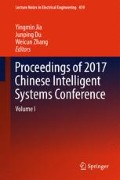Abstract
This paper investigates mainly stability problem of equilibrium points for a class of Caputo fractional time-varying systems with nonlinear dynamics. By employing Gronwall-Bellman’s inequality, Laplace transform and estimates of Mittag-Leffler functions, when the fractional-order belongs to the interval (0, 2), several stability criterions for fractional time-varying system described by Caputo’s definition are presented. Besides, some problems about the stability of fractional time-varying systems in existing literatures are pointed out. Finally, an example and corresponding numerical simulations are presented to show the validity and feasibility of the proposed stability criterions.
Access this chapter
Tax calculation will be finalised at checkout
Purchases are for personal use only
References
Podlubny I. Fractional differential equations. NewYork: Academic; 1999.
Zhou Y (2014) Basic theory of fractional differential equations, World Scientific Publishing Co. Pte. Ltd., Hackensack, NJ
Matignon D. Stability results for fractional differential equations with applications to control processing. Comput Eng Syst Appl. 1996;2:963–8.
Trigeassou J, Maamri N, Sabatier J, Oustaloup A. A Lyapunov approach to the stability of fractional differential equations. Signal Process. 2011;91(3):437–45.
Li Y, Chen Y, Pudlubny I. Mittag-Leffler stability of fractional order nonlinear dynamic systems. Automatica. 2009;45(8):1965–9.
Chen L, Chai Y, Wu R, Yang J. Stability and stabilization of a class of nonlinear fractional-order systems with Caputo derivative. IEEE Trans Circuits Syst II, Express Briefs. 2012;59(9):602–6.
Ge F, Kou C. Stability analysis by Krasnoselskii’s fixed point theorem for nonlinear fractional differential equations. Appl Math Comput. 2015;257:308–16.
Li C, Zhang F. A survey on the stability of fractional differential equations. Eur Phys J Spec Top. 2011;193:27–47.
Gallegos J, Duarte-Mermoud M. Boundedness and convergence on fractional order systems. J Comput Appl Math. 2016;296:815–26.
Huang S, Zhang R, Chen D. Stability of nonlinear fractional-order time varying systems. ASME J Comput Nonlinear Dyn. 2016;11(3):031007.
Sabatier J, Farges C, Oustaloup A. Fractional systems state space description: some wrong ideas and proposed solution. J Vib Control. 2014;20(7):1076–84.
Wen X, Wu Z, Lu J. Stability analysis of a class of nonlinear fractional-order systems. IEEE Trans Circuits Syst II, Express Briefs. 2008;55(11):1178–82.
Zhang R, Tian G, Yang S, Cao H. Stability analysis of a class of fractional order nonlinear systems with order lying in (0, 2). ISA Trans. 2015;56:102–10.
Diethelm K, Ford NJ, Freed AD. A predictor-corrector approach for the numerical solution of fractional differential equations. Nonlinear Dyn. 2002;29(1–4):3–22.
Acknowledgements
This work was supported by the National Nature Science Foundation (No. 61327807, No. 61573034).
Author information
Authors and Affiliations
Editor information
Editors and Affiliations
Appendix
Appendix
Let us modify the system (12) as the following system, where \(\alpha =0.95\).
where \(\frac{d^{\alpha }}{dt^{\alpha }}\) stands for Caputo fractional derivative operator, \(x(t)=[x_{1}(t),x_{2}(t)]^T\) is the pseudo-state vector of the system. Subsequently, one gets

By the equations \(\det (\lambda I-\bar{A})=0\) and  , one can calculate the corresponding eigenvalues as:
, one can calculate the corresponding eigenvalues as:
Then, \(|{\arg ({\lambda _i}(\bar{A}))}|=1.6267\) and  , which implies that
, which implies that  . Consequently, it is easy to calculate that \(\Vert {\bar{A}}\Vert =10.0952\),
. Consequently, it is easy to calculate that \(\Vert {\bar{A}}\Vert =10.0952\),  ,
,  , \(\alpha \Vert {\bar{A}}\Vert = 9.5904\),
, \(\alpha \Vert {\bar{A}}\Vert = 9.5904\),  , and \({\mathop {\lim }\limits }_{x \rightarrow 0} \frac{{\left\| {f(x(t))} \right\| }}{{\left\| {x(t)} \right\| }} = {\mathop {\lim }\limits }_{x \rightarrow 0} {\frac{0.1\sqrt{{{({x_{1}}{x_{2}})}^{2}}}}{\sqrt{x_{1}^{2} + x_{2}^{2}}}} \le 0.05 {\mathop {\lim }\limits }_{x \rightarrow 0} \sqrt{x_{1}^{2} + x_{2}^{2}} = 0\).
, and \({\mathop {\lim }\limits }_{x \rightarrow 0} \frac{{\left\| {f(x(t))} \right\| }}{{\left\| {x(t)} \right\| }} = {\mathop {\lim }\limits }_{x \rightarrow 0} {\frac{0.1\sqrt{{{({x_{1}}{x_{2}})}^{2}}}}{\sqrt{x_{1}^{2} + x_{2}^{2}}}} \le 0.05 {\mathop {\lim }\limits }_{x \rightarrow 0} \sqrt{x_{1}^{2} + x_{2}^{2}} = 0\).
Obviously, the system (13) satisfies the three conditions which are shown in the literature [10]. However, the state of system (13) cannot converge to zero as time t tends to infinity. In the following, Adams-Bashforth-Moulton predictor-corrector algorithm [14] is employed to the numerical calculation of fractional system. When the initial condition \((x_1(0), x_2(0))=(0.1, 0.1)\), the system (13) can generate subharmonic, harmonic or almost-periodic oscillation and even yield a chaotic trajectory. Its chaotic figure is shown in Fig. 3, while Fig. 4 depicts the evolution of the trajectories \(x_1(t)\) and \(x_2(t)\) of system (13). Therefore, the proposed results of paper [10] are not correct. Since the matrix A(t) of system may depend on time t, we cannot select the lower and upper boundaries of the time matrix A(t) to determine the stability of the zero solution of the time-varying system with integer-order or fractional-order differential operator. Meanwhile, the stability criterions of our presented paper is not used to check the convergence and divergence of the system (13) as well; it will be our future topic of research.
Rights and permissions
Copyright information
© 2018 Springer Nature Singapore Pte Ltd.
About this paper
Cite this paper
Guo, Y., Ma, B. (2018). Stability Analysis for a Class of Caputo Fractional Time-Varying Systems with Nonlinear Dynamics. In: Jia, Y., Du, J., Zhang, W. (eds) Proceedings of 2017 Chinese Intelligent Systems Conference. CISC 2017. Lecture Notes in Electrical Engineering, vol 459. Springer, Singapore. https://doi.org/10.1007/978-981-10-6496-8_36
Download citation
DOI: https://doi.org/10.1007/978-981-10-6496-8_36
Published:
Publisher Name: Springer, Singapore
Print ISBN: 978-981-10-6495-1
Online ISBN: 978-981-10-6496-8
eBook Packages: EngineeringEngineering (R0)



